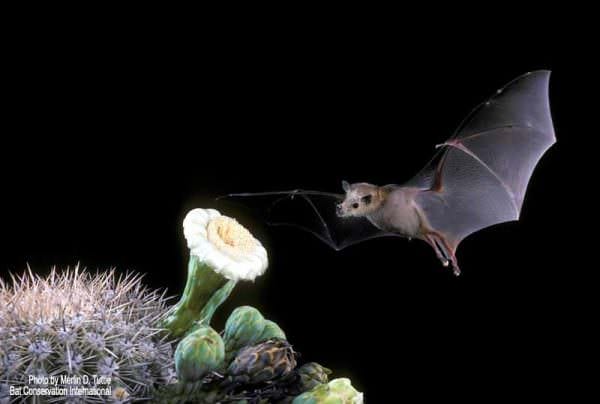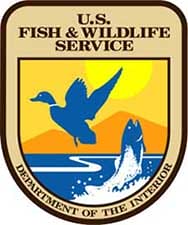Service-led partnerships with local communities, conservation groups, agencies and Mexico bring bat back from the brink of extinction.

USA – -(Ammoland.com)- A charismatic, winged pollinator responsible for helping produce tequila is making a comeback despite tough odds thanks to a U.S. Fish and Wildlife Service-led three-decade partnership. Although many bat species in North America today are vexed with declining populations, partners in the United States and Mexico have helped recover the lesser long-nosed bat, which today becomes the first bat ever removed from Endangered Species Act (ESA) protections due to recovery.
When initially protected under the ESA in 1988, there were fewer than 1,000 of the nectar-feeding bats at 14 known roosts range wide. Today, there are an estimated 200,000 bats at 75 roosts in the U.S. Southwest and Mexico.
“The science clearly shows threats to the bat have been eliminated or reduced to the point that the bat has recovered,” said Service Southwest Regional Director Amy Lueders. “The Service is proud of our strong, decades-long partnerships with very diverse stakeholders on behalf of the lesser long-nosed bat. Without partnerships and collaborations such as these, successful recovery would not be possible.”
“It is great to see the lesser long-nosed bat has reached its recovery goals and is no longer under imminent threat of extinction,” said Dr. Winifred Frick, Bat Conservation International’s chief scientist. “Scientists and conservation groups in both Mexico and in the U.S. have worked together over the years to protect the species and mitigate the threats to its long-term viability. The story of the lesser long-nosed bat shows that conservation and science work together to provide species the chance to recover and persist.”
“Any time we can properly recover a species so that it can be removed from the Threatened and Endangered Species List is a great day for wildlife conservation,” said Jim deVos, Assistant Director of the Arizona Game and Fish Department. “Through the dedicated boots-on-the-ground work of multiple partners, the overall population trend for lesser long-nosed bats appears to be increasing and conservation actions are in place to ensure that remaining threats are minimized. We support the U.S. Fish and Wildlife Service’s action to remove the species from the list of threatened and endangered species.”
The successful recovery is an international team effort comprised of biologists and researchers in the United States and Mexico, state, federal and Tribal entities, non-governmental organizations, and citizen scientists in Pima County, Arizona, and tequila producers in Mexico. The lesser long-nose bat is an important pollinator and seed disperser of the Sonoran Desert’s emblematic saguaros and Mexico’s tequila-producing agave. The bat also contributes to healthy soils and habitats and provides sustainable economic benefits for communities in both nations.
For a decade, southern Arizona residents have monitored night-time bat use of hummingbird feeders. These data provided biologists with a clearer understanding of lesser long-nosed bat migration timing. These residents also voluntarily supported biologists in capturing bats and affixing radio transmitters to them that aid in finding roost sites.
In the United States, most lesser long-nosed bat roost and forage areas are managed by federal agencies (U.S. Forest Service, Bureau of Land Management, National Park Service and the U.S. Army’s Fort Huachuca). All have integrated the management of lesser long-nosed bat forage plants – agaves, and saguaro and organ pipe cacti – into their land use and resource management plans. Agencies also helped deter human disturbance of roost site caves and abandoned mines. With the assistance of state agencies and Bat Conservation International, stakeholders designed and installed bat gates that allow bat access to roost sites and eliminate human access.
In Mexico, tequila producers, who rely on and cultivate agaves, are integrating harvest and cultivation practices in recognition that agaves symbiotically rely on bats for pollination and are even marketing “bat friendly tequila.” Historically, the control of vampire bats for rabies control and to reduce impacts to the livestock industry destroyed roost sites of non-target bats like the lesser long-nosed bat. An active education campaign is helping change attitudes regarding the conservation of bats and improve bat identification and appreciation. As a result of reduced threats and improved population numbers, the bat was removed from Mexico’s endangered species list in 2015.
To ensure the lesser long-nosed bat continues to thrive following its delisting, the Service will soon release a draft Post-Delisting Monitoring Plan. Together with conservation partners, the Service is committed to monitoring the lesser long-nosed bats’ continued roost occupancy, as well as monitoring and assessing the bats’ forage availability.
Lesser long-nosed bats range from southern Mexico to southern Arizona and New Mexico. Some Mexican populations are year-round residents. The migratory ones leave southern Mexico only to find maternity roosts in northern Mexico and Southwestern U.S. ., where arriving pregnant females have access to forage for birthing and nursing their pups. The bats’ migrations and maternity roosting are reliant on timing and location of the “nectar trail” – the blooming and fruiting season of agaves, saguaros and organ pipe cacti, among other flowering plants that provide their nutrient-rich nectar diet. Bat colonies seek out roost sites in caves, abandoned mines and large crevices and will travel up to 40 miles each night to reach their nocturnal foraging areas.
The delisting determination draws upon a scientific species status assessment – an evaluation of threats and an assessment of the bat’s long-term viability. The species status assessment also considered the potential effects that a changing climate may have on the nectar trail and the bats’ foraging, migration and roosting cycles. The lesser long-nosed bat has shown the ability to adapt to adverse forage conditions, and biologists found that its flexible and adaptive behaviors will allow it to remain viable under changing climatic conditions.

The mission of the U.S. Fish and Wildlife Service is working with others to conserve, protect, and enhance fish, wildlife, plants, and their habitats for the continuing benefit of the American people. We are both a leader and trusted partner in fish and wildlife conservation, known for our scientific excellence, stewardship of lands and natural resources, dedicated professionals, and commitment to public service. For more information on our work and the people who make it happen, visit www.fws.gov.
For more information on our work and the people who make it happen, visit http://www.fws.gov/. Connect with our Facebook page, follow our tweets, watch our YouTube Channel and download photos from our Flickr page.
